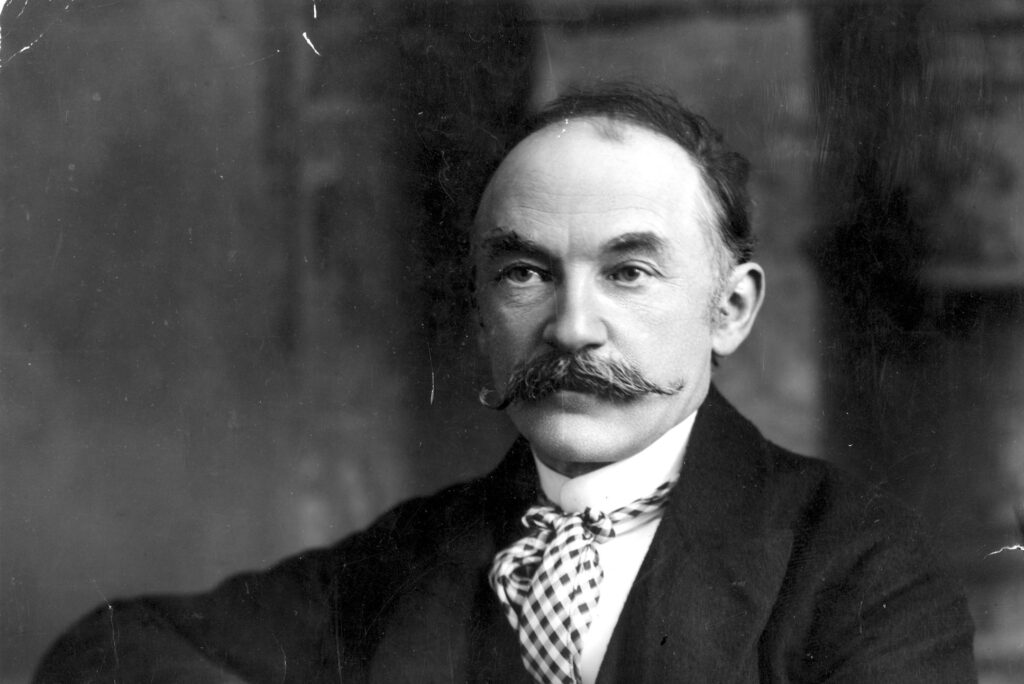Thomas Hardy was born in 1840 in Dorset, England. His father was a stonemason and a local builder. His mother was a well-read and educated woman. Thomas went to school at age eight. There he learned Latin and showed his potentials in education. However, his family was poor and could not provide their son with the means to complete his university education and resultantly his formal education ended when he was eighteen. He got training as an architect and moved to London in 1862. There he got admission into King’s College, London. He won different prizes in his field of architecture. He was extremely aware of class differences and his inferior social status. However, his great interest was in social reforms. He took a keen interest in the works of John Stuart Mill. He also read works of Charles Fourier and Auguste Comte.
Thomas fell in love with Emma Lavinia Gifford and married her in 1874. His wife’s death in 1912 had a shocking effect on him. Thomas Hardy visited all those places associated with his dead wife in one way or the other and gave her a central place in his poems 1912-13 which reflected upon her passing away. Hardy married Florence Emily Dugdale in 1914 that was 39 years younger than him. However, he could not forget his first wife and out of his repentance, he wrote poetry in order to remember her.
Poetic works of Thomas Hardy
Hardy got ill with pleurisy in 1927 and died in January 1928. He dedicated his final poems to his wife while he was on his deathbed. His funeral was held on 16 January but the burial of his body became controversial. However, a compromise was reached and his heart was buried at Stanford with his previous wife Emma, and his body ashes in the poet’s corner.
Although he was a great poet, he also wrote many great novels for which he is mostly remembered. His poetry could not be published until after 1898. Hardy preferred his poetry to his novels and considered them simply a way of earning life. Undoubtedly he was keen to write his novels to the necessities of magazines. It was a thrill in every episode and nothing to discourage or hurt the feelings of feminine readers. His novels revolve around the imaginary world of Wessex, which is a large area south of England. He had a deep emotional affiliation with rural life and was a staunch opponent of the industrial revolution and the use of technology in agriculture.
Hardy as a Poet
In most cases, Hardy delayed the publication of his poems, and resultantly it is difficult to know Hadry’s growth as a poet. In fact, he hardly developed at all. The last poems are extremely similar in diction, meter, and feeling to the first. Because of this, his poems are usually divided into three groups: naturalistic poems, love poems, and theological poems. Most of his poems are about the themes of disillusionment in love and life and man’s long resistance against apathy to human misfortunes. A strong note of pessimism appears in his poetry as well as his novels. His poems are embedded with tones of remorse. A predominantly central theme in the Wessex Poems is the long murkiness that the Napoleonic Wars threw over the nineteenth century, for example, in “The Sergeant’s Song”
In most of his poems, Hardy has used Victorian diction, usual meters, and orderly stanzas. His effective acknowledgment is as of a Victorian poet. But he also uses layman words in his poetry which makes it easily understandable to ordinary people. These, with his pessimistic view of human destiny and his merging of wit and compassion, place him in the lines of the modern poets.

